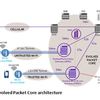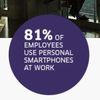By: Jérôme Brouet, Public Safety Solution Director, Alcatel-Lucent
From original Alcatel-Lucent TechZine posting
Public safety professionals require the highest level of reliable, multimedia mobile communications to enhance their operational effectiveness. And while standard based long term evolution (LTE) provides the most cost-effective and secure way to support these broadband communications, transitioning to this new technology will demand a complex technical, operational, and business evolution for the public safety community.
Why LTE – and why now?
Public safety communications are at a turning point. The most urgent events – planned and unplanned – require more than mission-critical voice to improve first responders’ efficiency. Real-time imagery, video, geo-localization, and high-speed access to private cloud-based information and applications are becoming essential to fulfill first responders’ missions.
Existing private mobile radio (PMR) systems have limited capabilities to deliver this, because they were designed to primarily support narrowband mission-critical voice.
For LTE, it’s a different story. LTE can complement existing PMR networks to dramatically enhance operational effectiveness and coordination within a secure infrastructure shared by cooperating agencies.
LTE operational benefits include:
- Enhanced situational awareness: Command and control officers can obtain and immediately share essential video and data with field officers.
- Enhanced interoperability and collaboration: LTE inherently offers interoperability and roaming capabilities among public safety organizations that use LTE, as well as interworking with legacy PMR systems.
- Affordable flexibility and evolution: LTE brings economies of scale by leveraging the broad ecosystem nurtured by commercial deployments worldwide. LTE also enables network sharing with other agencies, which can further optimize the cost.
However, adding LTE mobile broadband capabilities to existing PMR networks in a non-disruptive and cost-effective way can be complex, with many factors to consider. Fortunately, proven roadmaps exist for a smooth migration that leverages existing infrastructure and investments and adapts to local constraints.
5 proven business models to transition to LTE
When evolving to mobile broadband, public safety agencies have a choice among many business models to get broadband PMR services. In all models, public safety organizations are responsible for purchasing the applications and the terminals that will operate over the 4G radio access network.
The models include:
1. Mobile network operator (MNO) – Using existing commercial LTE network for public safety forces
In this model, the public safety agency contracts data subscriptions with an MNO to provide mobile broadband services.
Public safety users and consumers share the same spectrum and network. The public safety entity pays a consistent, predictable periodic fee for network access, usually a function of some known factors, such as the number of end users, devices, or usage.
2. Government mobile virtual network operator (G-MVNO) – Operating or getting service from a G-MVNO
The mobile virtual network operator approach has become prevalent in the commercial sector, where operators resell bulk-purchased wireless services to consumers while providing their own usage plans, billing, and customer support.
In this model, the MVNO approach can be extended to public safety users. A G-MVNO provides added-value services (e.g., security, selection of best access) to the public safety users. These users get access to secure broadband data services when the G-MVNO leverages the 4G access network from the MNO.
G-MVNO services can be operated by the public safety entity itself or by a public or private organization. Furthermore, when dedicated spectrum becomes available for public safety, the core network elements deployed for the G-MVNO can also be used for the core network of the dedicated radio access (see model 5).
3. Public-private partnership (PPP) – Deploying dedicated network services through a PPP project
The public-private partnership business model features a dedicated and standalone LTE network which is deployed, operated, and maintained by an MNO and/or any other independent operator. The network is typically owned by a telecom operator, which provides the service to the public safety agencies while usually assuming the financial, technical, and operational risk of the service offer.
The infrastructure can be complemented by rapidly deployable LTE systems to enable the extra capacity or coverage required to cope with major planned or unplanned events and major disaster when fixed infrastructure has been destroyed.
4. Private – Building a dedicated network
In this model, the public safety agency finances, procures, builds, and manages its own network, setting technical requirements for capacity, security, reliability, redundancy, and robustness. The agency is responsible for all network elements and software, and employs in-house personnel to build, manage, operate, and maintain the network.
The extent of upfront costs depends on the scale of deployment (local, regional, or national), whether the network is shared among several entities and/or whether the deployment is scheduled gradually over years or within a shorter time period.
5. Hybrid – Combining a G-MVNO with a private network
Where spectrum is scarce, some agencies may opt for custom communications network dedicated to mission-critical services, while conducting less critical back-office operations through commercial operators using the G-MVNO model.
This approach can be easy to implement, since LTE is both a technology for commercial carriers and the new-generation platform for PMR.
LTE network deployment considerations
To choose amongst these different possibilities, public safety agencies embarking on an LTE deployment project must consider the following requirements and criteria:
- Budget: What are their capabilities, both in term of capital expenditure (CAPEX) and operation expenses (OPEX) in the short and longer run?
- Timing: When do they need to deploy the services and when do they have access to dedicated spectrum? Which one (frequency is a key parameter for CAPEX)? And how much bandwidth?
- Coverage and capacity targets over time.
- Number of end users on the public safety network.
- Public safety specific services and high availability: What will be the public safety applications running over the LTE network? And for each of them, what will be the level of mission-criticality?
- Security levels per type of application.
- Control: Which trade-off on the level of control on the network are they ready to accept?
- Regulatory issues, particularly if they consider re-selling extra capacity to other public agencies.
- Internal resource constraints to deploying and managing the network. And their level of expertise vis-à-vis the new LTE and IP/MPLS technologies.
Based on these main criteria, Figure 1 below summarizes the merits of each model using a simplified color code (green = very good, yellow = good, orange = fair, red = poor).
Figure 1: Merits of the 5 business models
Accelerating the adoption of broadband public safety communications
Given the very specific constraints of public safety communications in term of services, high availability during crisis, security, and coverage, each public safety network operator should aim to deploy its own dedicated LTE network.
Nevertheless, budgetary, in-house expertise, or spectrum availability constraints also make alternative models such as G-MVNO sensible intermediary steps to speed the adoption of broadband services for public safety forces.
Last but not least, regardless of the model chosen, the public safety agencies should also have a plan for doctrine change management, since broadband public safety services will offer new ways of conducting operations.
Related Material
- Ultra-Broadband PMR: Five Business Models For Enhanced Mission Critical Operations strategic white paper
- Alcatel-Lucent Communications for Public Safety solution page
- LTE for public safety webpage
To contact the authors or request additional information, please send an email to [email protected].












